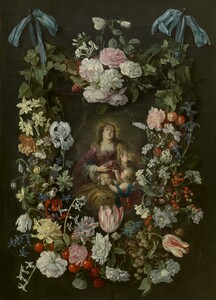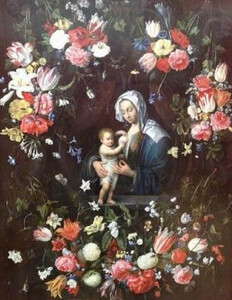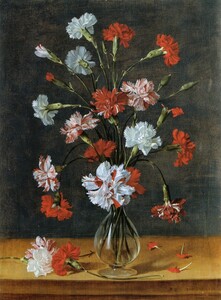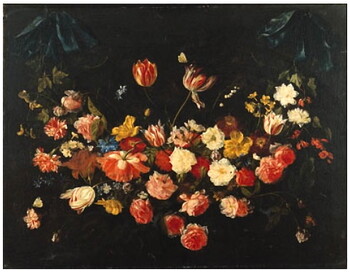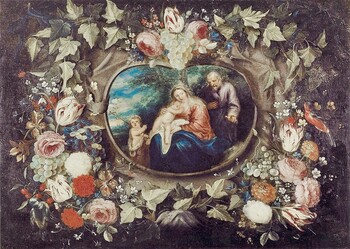7.700 €
A flower wreath around the mystical marriage of Saint Catherine of Alexandria
Oil on copper : 54,8 X 68,8 cm
Unsigned
Frame : 73,3 X 87,4 cm
I would like to thank Fred Meijer who has given us the attribution 4/06/25
In short
After his return to Antwerp circa 1634 Philips de Marlier’s style evolved rapidly in just a few years time: from rather traditional, old-fashioned still lifes to a more modern, personal treatment of his subjects by 1638. Fred Meijer dates our painting circa 1640/45.
The figures at the centre have been painted by a contemporary, unidentified, Flemish staffage painter.
Saint Catherine of Alexandria was a very popular virgin martyr who, in a vision, was married with Christ.
About Philips de Marlier
Flemish painter
Antwerp circa 1600 – 1667/68 Antwerp
Still life painter.
Pupil in Antwerp in 1617/18 of the further unknown Carel van Ferrrara (Antwerp circa 1585 – 1667 Antwerp).
Master in the Painter’s Guild of Saint Luke in Antwerp from 1621/22.
In the period 1627 – 1634 de Marlier left Antwerp. According to Duverger (1971, P. 175 – 194) he is said to have killed a Dominican father while in Portugal. After this incident he fled to Mons, where he stayed with a Master Jorge.
He was back in Antwerp in 1634 and apparently never left the town again.
De Marlier was nicknamed “Dicke Lup”, that is “Fat Lip” and “Dicken Philips”, that is “Fat Philips”.
He seems to have had a bad reputation in Antwerp: his ideas about politics and religion were not really mainstream, nor was his knowledge of witchcraft; finally he did not have much respect for property or fame of others. Not the perfect son-in-law, but a good and hard working painter.
The still life painter Carstian Luyckx (1623 – after 1657) was his most important pupil (in 1640/41). Luyckx also studied under Frans Francken III in the year 1642/43.
Text of the certificate by Fred Meijer, 4/06/25
“The flower wreath seems to me to be attributed to Philips de Marlier and to date around 1640-1645. His work from the mid-1630s is rather stiff, but then he makes a change, culminating in the beautiful work from 1639 and 1640 (https://rkd.nl/imageslite/87169 and https://rkd.nl/imageslite/89904).
I attributed a similar composition to him before (https://rkd.nl/images/196889), although that painting is probably a bit earlier.”
RKD Nr.87169 is the flower still life sold at Christie’s New York, 26/01/01.
RKD Nr. 89904 is the flower wreath with Saint Dorothea of Caesarea from the Royal Museum of Fine Arts in Antwerp.
RKD Nr. 196889 is the flower and fruit wreath around the Holy Family sold at Dobiashofsky Bern 12/11/05.
About our flower wreath
De Marlier’s career can be divided into two very distinct halves: before and after circa 1638.
He started in a rather archaic style with compositions and a colour scheme that were strongly inspired by earlier Antwerp painters, from the first quarter of the 17th century, such as Jan Brueghel I and Osias Beert.
Very rapidly, around 1638, de Marlier changed to a more modern interpretation of his subjects.
From the early 1640s a lot of the flower garlands painted by de Marlier were apparently exported by the two main international dealers in Antwerp paintings.
- The company of Guillam I Forchondt (also known as Forchoudt), himself also a painter, exported a lot of artwork to Central Europe (especially to Vienna) and to a lesser extent to Spain (and Portugal).
- His main concurrent was Matthijs Musson who specialised in export to Holland, Paris and Spain.
De Marlier’s paintings seem to have been especially sought after in Portugal, a country where he lived for a few years at the very start of his career.
About the centre piece of our painting
Catherine of Alexandria lived during the 4th century AD. She converted to Christianity and in a vision she experienced a mystic wedding ceremony with Christ. This was often represented as Christ placing a ring round her finger, symbolising their spiritual union. As she refused to give up her faith the Roman Emperor Maxentius ordered that she be tortured to death on a spiked breaking wheel, but at her touch it was destroyed. Catherine was then beheaded.
This story is recorded in the Golden Legend or Legenda Aurea, a collection of legendary lives of the most important saints of the medieval church. It was written, or better compiled, around 1265 by the Italian chronicler and archbishop of Genoa Jacobus de Voragine (circa 1230 – 1298). It became one of the most popular religious books of the Middle Ages: it was translated in many languages, the oldest version in Middle Dutch dates from 1357. During the 16th and 17th century many popular religious themes in painting and in sculpture went back to these hagiographic tales.
About tulips
Tulip bulbs were introduced from Turkey to Europe around the middle of the 16th century. The intensity of the colours of its petals was unseen in Europe.
By the end of the 16th century the highly influential Flemish horticulturist Carolus Clusius discovered tulips could be cultivated in the botanic gardens of the university of Leiden. He also observed the flaming and feathering “broken” patterns of tulips. This was the start of its cultivation and of its popularity in Holland.
Tulip bulbs became a frenzied commodity. Between 1634 and 1637, the enthusiasm for the new flowers triggered a speculative frenzy now known as the tulip mania. Tulip bulbs became so expensive that they were treated as a form of currency, or rather, as futures. By 1636 the tulip bulb became the fourth leading export product of the Netherlands, after gin, herrings and cheese. In February 1637 prices suddenly collapsed: this was the first recorded speculative bubble, be it still limited to a fairly small group of people.
Why should you buy this painting?
Because the trompe l’oeil effect of our painting is very convincing: an almost weightless floral garland is draped around an oculus in a stone wall. Through this window we see a popular religious subject painted by a talented contemporary staffage painter: Christ offering a ring to Saint Catherine of Alexandria as a symbol of their union.
Comparative paintings
Click photos for more details

